Mothballs may seem harmless, but they can be extremely toxic to dogs. These small spheres contain substances that can cause a range of symptoms in dogs, including nausea, vomiting, respiratory irritation, anemia, organ damage, and even death. It’s crucial for pet owners to be aware of the risks associated with mothballs and take necessary precautions to keep their furry friends safe.
When it comes to keeping pets safe from mothballs, prevention is key. By understanding the dangers and implementing preventive measures, you can significantly reduce the risk of toxicity in dogs. In this article, I will provide in-depth information about the toxic properties of mothballs, the risks they pose to dogs, and effective prevention measures to ensure your beloved pets stay safe.
Key Takeaways:
- Mothballs contain toxic substances that can be harmful to dogs if ingested or exposed to for a prolonged period of time.
- The active ingredients in mothballs, such as naphthalene and paradichlorobenzene, can cause various symptoms and even death in dogs.
- Preventing mothball poisoning involves using natural alternatives, storing clothes properly, and keeping mothballs out of dogs’ reach.
- If you suspect your dog has ingested a mothball, seek immediate veterinary care.
- Understanding the risks and taking preventive measures can help keep your pets safe from the toxic effects of mothballs.
What are Mothballs and How are They Used?
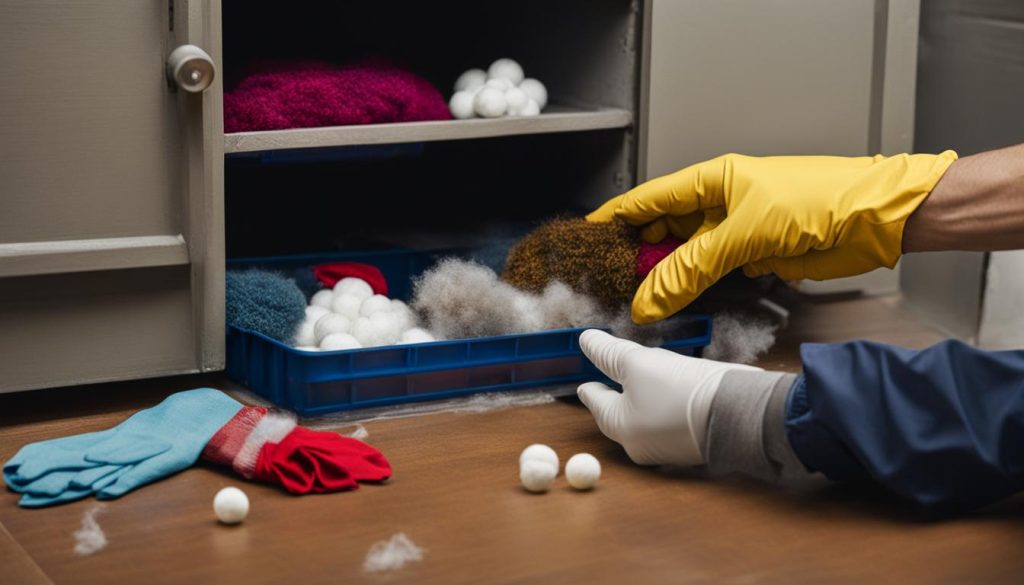
Mothballs are small, solid spheres that serve as an effective repellent for cloth moths and other fabric-eating pests. They release pesticide vapors that not only deter pests, but also kill them when exposed for an extended period of time. The purpose of mothballs is to protect clothes from damage caused by these destructive insects.
Mothballs are typically used in sealed containers, cabinets, and wardrobes to create an environment that discourages moth infestations. By placing mothballs strategically, you can safeguard your favorite garments from being devoured by hungry fabric pests.
The process of using mothballs involves simply placing them in the areas where clothes are stored and may be susceptible to moths. These small balls emit a gas that repels the pests, ensuring that they don’t get near your valuable garments. However, it’s essential to note that while mothballs are effective for their intended purpose, they do come with potential risks, especially for dogs.
| Step | Description |
|---|---|
| 1 | Identify areas prone to moth infestations, such as closets, drawers, and storage containers. |
| 2 | Place mothballs in a varied pattern throughout the storage areas, ensuring even distribution. |
| 3 | Close the containers or seal off the storage areas to prevent the gas from dissipating. |
| 4 | Refresh the mothballs periodically to maintain their potency. |
| 5 | Keep mothballs out of reach of pets to prevent accidental ingestion. |
Overall, mothballs are an effective solution for protecting your clothes from moth damage. However, it’s crucial to understand and mitigate the potential risks associated with their use, especially when it comes to the safety of your furry friends.
In the next section, we will explore why mothballs are toxic to dogs and the potential dangers that arise when dogs come in contact with these small but dangerous spheres.
Why are Mothballs Toxic to Dogs?
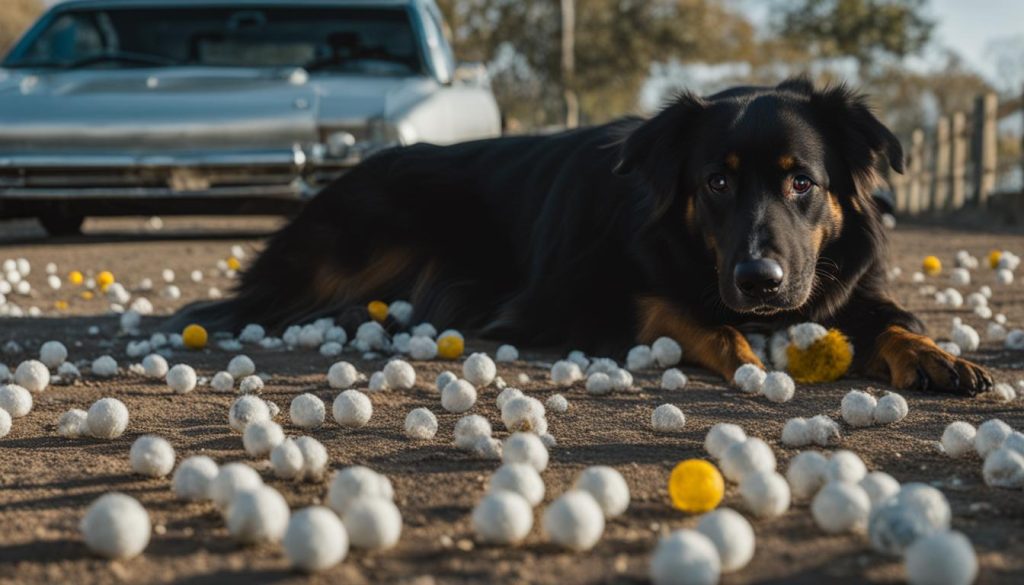
Mothballs contain toxic substances that are harmful to dogs. These toxic properties pose dangers to dogs through ingestion or exposure to the fumes emitted by the mothballs.
The main toxic ingredient in mothballs is naphthalene. When dogs ingest or inhale naphthalene, it can damage their red blood cells, leading to anemia and organ failure. Additionally, paradichlorobenzene and camphor, other common ingredients in mothballs, can cause a range of adverse effects on dogs, including gastrointestinal issues, organ damage, and nervous system disorders.
Dogs can be exposed to these toxic substances in various ways. If they accidentally ingest mothballs, either by eating or chewing on them, they can experience the toxic effects firsthand. Moreover, extended exposure to the fumes emitted by mothballs can also lead to toxic effects in dogs.
It is crucial for dog owners to understand the dangers associated with mothballs and take necessary precautions to keep their pets safe. Preventing access to mothballs and using natural alternatives can significantly reduce the risk of toxicity in dogs.
How Many Mothballs Could Be Toxic to A Dog?

Even a small amount of mothballs can be toxic to dogs. It only takes one piece of mothball containing naphthalene to poison a dog. The dosage can be even smaller if the mothball contains a higher concentration of naphthalene. For example, 1.5 grams of naphthalene mothballs per kilogram of a dog’s weight can cause hemolytic anemia. The symptoms of mothball poisoning can appear as early as 48 to 96 hours after exposure to the fumes.
Mothballs pose a significant risk to dogs, even in small quantities. Just one mothball containing naphthalene can be enough to poison a dog, especially if it has a higher concentration of this toxic substance. To put it into perspective, a dose of 1.5 grams of naphthalene mothballs per kilogram of a dog’s weight can result in hemolytic anemia.
The symptoms of mothball poisoning may not present immediately, but can appear as early as 48 to 96 hours after exposure to the fumes. It is crucial to be aware of the potential dangers and take precautions to keep dogs safe from mothballs.
| Mothball Dosage | Potential Effect |
|---|---|
| 1 piece of mothball containing naphthalene | Poisoning |
| Higher concentration of naphthalene in the mothball | Increased toxicity |
| 1.5 grams of naphthalene mothballs per kilogram of dog’s weight | Hemolytic anemia |
What are the Clinical Signs and Symptoms of Mothball Poisoning?
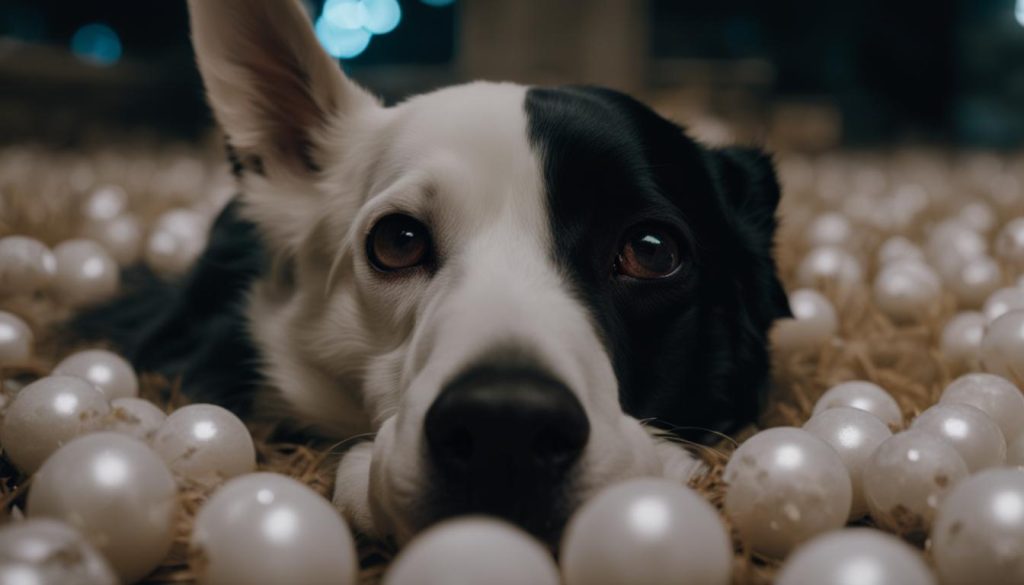
Mothball poisoning in dogs can have various clinical signs and symptoms, indicating the toxic effects of these substances on their bodies. It’s crucial to recognize these symptoms promptly and seek veterinary help for proper diagnosis and treatment. The symptoms of mothball poisoning in dogs may include:
- Nausea and vomiting: Dogs may experience stomach upset, leading to frequent episodes of vomiting.
- Respiratory irritation: Inhalation of mothball fumes can cause respiratory distress and irritation in dogs.
- Weakness: Dogs affected by mothball poisoning may exhibit weakness and lack of energy.
- Lack of appetite: Loss of appetite is a common sign seen in dogs suffering from toxin ingestion.
- Pale gums: Mothball toxicity can impact the dog’s circulation, leading to pale gums.
- Red urine: The presence of blood in the dog’s urine may occur due to mothball poisoning.
- Yellowing of the skin/whites of the eyes: Jaundice, a yellow discoloration of the skin and eyes, can manifest as a result of significant liver damage caused by mothball toxicity.
- Collapse and death: In severe cases, dogs may experience sudden collapse and potentially fatal complications.
Mothball poisoning can also lead to kidney and liver damage, contributing to additional symptoms such as vomiting blood, blood in the urine or stool, and jaundice. It is important to be vigilant and seek immediate veterinary care if you suspect your dog has been exposed to mothballs.
| Clinical Signs and Symptoms of Mothball Poisoning |
|---|
| Nausea and vomiting |
| Respiratory irritation |
| Weakness |
| Lack of appetite |
| Pale gums |
| Red urine |
| Yellowing of the skin/whites of the eyes |
| Collapse and death |
| Kidney and liver damage |
| Vomiting blood |
| Blood in the urine or stool |
| Jaundice |
Can Mothballs Kill Dogs?
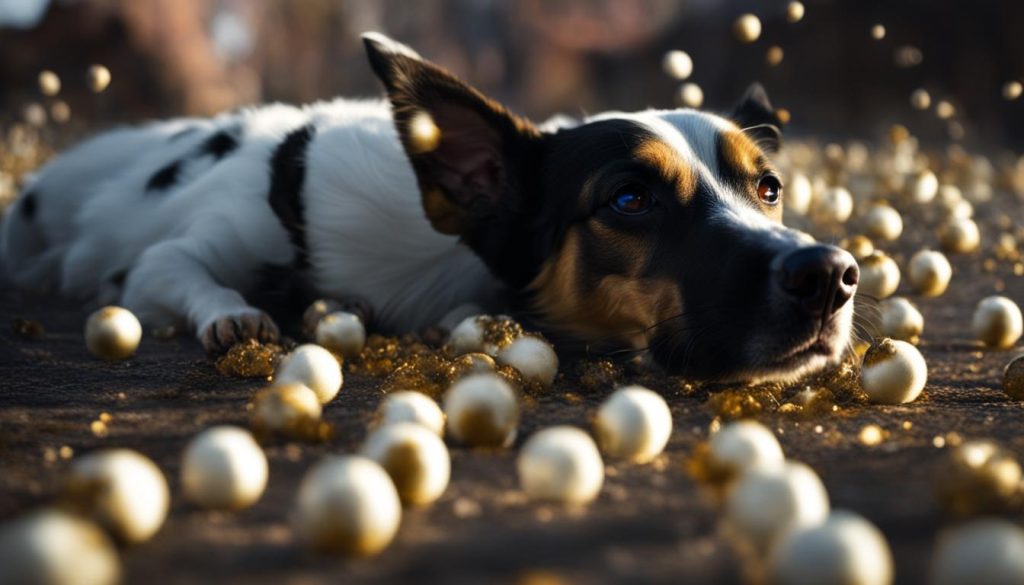
Mothball poisoning can have severe and potentially fatal effects on dogs. While some cases may result in mild reactions, the toxicity of mothballs, particularly the chemical naphthalene, can cause irreversible harm to a dog’s organs and nervous system. It is crucial to take immediate action and seek veterinary care when dealing with mothball ingestion in dogs.
The severity of mothball toxicity on dogs should never be underestimated. The toxic properties of mothballs can lead to lethal illnesses if left untreated. Naphthalene, one of the main ingredients in mothballs, can cause damage to a dog’s red blood cells, leading to anemia and organ failure. Dogs may also experience gastrointestinal issues, nervous system disorders, and respiratory distress as a result of mothball ingestion or exposure to its fumes.
Given the life-threatening nature of mothball poisoning, it is essential to treat it as an urgent situation. If you suspect that your dog has ingested a mothball or has been exposed to its fumes, it is crucial to contact your veterinarian immediately. Professional guidance is necessary to ensure the proper treatment and care for your dog.
Timely veterinary intervention is key to mitigating the fatal effects of mothball ingestion in dogs. It allows for the administration of appropriate treatments to counteract the toxic effects of mothballs and minimize further damage. Quick action is essential to prevent irreversible harm and increase the chance of a successful recovery.
To summarize, the lethality of mothball poisoning in dogs is a concerning reality. Immediate veterinary care is crucial when dealing with this type of toxicity. By acting swiftly and seeking professional help, you can give your dog the best chance of surviving mothball ingestion and reducing the severity of its harmful effects.
What Should I Do If My Dog Ate a Mothball?
If you suspect that your dog has ingested a mothball, it is important to act quickly to ensure their safety and well-being. Follow these steps for immediate response to mothball ingestion:
- Contact your veterinarian or a pet poison control hotline immediately. Provide them with all the necessary information, including the type of mothball ingested and any symptoms your dog may be experiencing.
- Follow their instructions for immediate treatment. They may recommend inducing vomiting or administering activated charcoal to help remove the poison from your dog’s system.
- If necessary, transport your dog to the nearest animal hospital for further medical care. Time is of the essence, so do not delay in seeking professional help.
- Bring a sample of the mothball product for identification purposes. This will assist the veterinary team in determining the specific ingredients and potential toxicity.
Remember, prompt action is crucial when it comes to mothball poisoning in dogs. By seeking veterinary assistance and following their guidance, you can give your dog the best chance of a full recovery.
How is Mothball Poisoning in Dogs Treated?
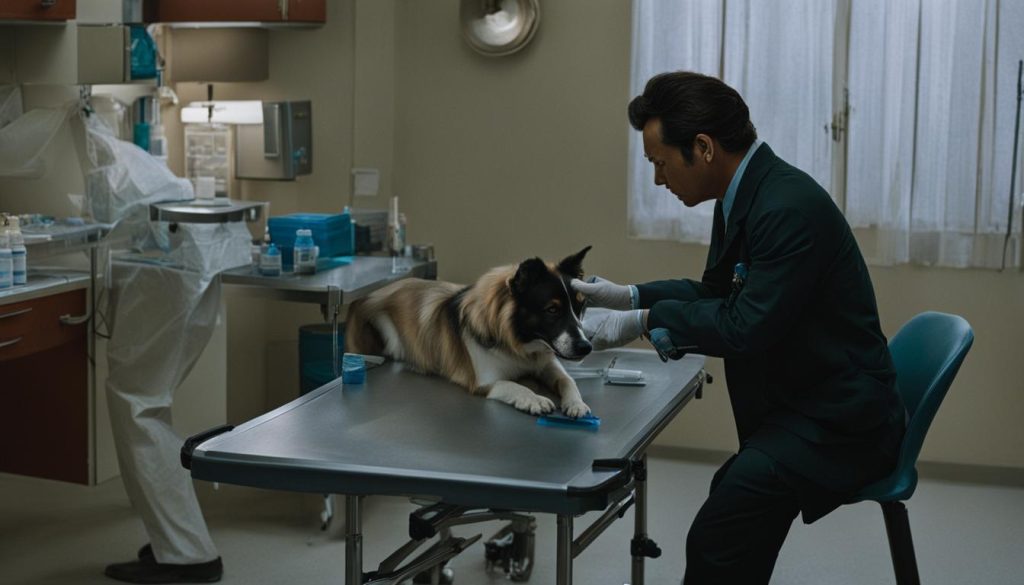
The treatment for mothball poisoning in dogs includes decontamination procedures and supportive care to manage the symptoms and help the dog recover. The specific treatment approach will depend on factors such as the extent of ingestion and the severity of the symptoms.
If the ingestion is recent and the symptoms have not fully manifested, induction of vomiting may be recommended to remove the poison from the dog’s system. The veterinarian may also administer activated charcoal, which can help bind the toxin and prevent further absorption in the digestive system.
Additionally, the dog may require supportive care such as intravenous (IV) fluids to maintain hydration and flush out the toxin from the body. In severe cases, blood transfusion may be necessary to address anemia caused by the toxic effects of mothballs.
The veterinarian will also monitor the dog’s organ function through bloodwork and radiographs, as mothball poisoning can potentially cause damage to the liver, kidneys, and other organs. This monitoring helps guide the appropriate treatment approach and ensures early detection of any complications.
It is important to note that there is no specific antidote for mothball poisoning. The treatment mainly focuses on managing the symptoms and providing supportive care to support the dog’s recovery. The veterinarian will tailor the treatment plan based on the individual dog’s condition and response to therapy.
| Treatment for Mothball Poisoning in Dogs | Description |
|---|---|
| Decontamination |
|
| Supportive Care |
|
Why Did My Dog Eat Mothball?
There are several reasons why dogs may eat mothballs. One common reason is curiosity, as dogs are naturally attracted to new scents and textures. Mothballs have a distinct odor that can pique a dog’s interest and make them want to investigate further. Additionally, some dogs may have a condition called pica, which is characterized by the urge to eat non-food items. This can lead them to ingest mothballs, thinking of them as edible objects.
Environmental factors can also play a role in mothball ingestion by dogs. If mothballs are easily accessible in the environment, such as being left within their reach or scattered around the house, dogs may be more likely to eat them. Improper storage of mothballs can also contribute to their ingestion by dogs. If mothballs are left out in the open or stored in containers that are not dog-proof, dogs may have easy access to them.
To prevent dogs from eating mothballs, it is important to take proactive measures. Keep mothballs securely stored in a place that is inaccessible to dogs, such as locked cabinets or high shelves. Consider using alternative methods to protect clothes from moths, such as cedar chips or herbal sachets. Regularly inspect your home for any stray mothballs and promptly dispose of them in a safe manner. By addressing these factors, you can reduce the risk of mothball ingestion in dogs and keep them safe from potential harm.
How Can I Prevent Mothball Poisoning?
To prevent mothball poisoning in dogs, it is important to take certain precautions. Use natural alternatives to mothballs, such as cedar, lavender, rosemary, or thyme scents, which may help deter clothes moths. Clean all clothes before storing them and store them in airtight containers. Open up drawers and cupboards to allow natural light in regularly. Keep mothballs out of reach of dogs and dispose of them properly as household hazardous waste. By following these prevention measures, you can help keep your dogs safe from the toxic effects of mothballs.
| Prevention Measures | Benefits |
|---|---|
| Use natural alternatives | Avoid exposure to toxic substances |
| Clean clothes before storage | Prevent moth infestation |
| Store clothes in airtight containers | Keep mothballs inaccessible to dogs |
| Allow natural light in regularly | Reduce moisture and moth-attracting conditions |
| Dispose of mothballs properly | Prevent accidental ingestion |
Wrapping Up
In summary, it is crucial for dog owners to be aware of the toxicity of mothballs and take necessary precautions to prevent their pets from ingesting or being exposed to these harmful substances. Mothballs contain toxic ingredients such as naphthalene, paradichlorobenzene, and camphor, which can cause a range of symptoms and even be life-threatening for dogs. Symptoms of mothball toxicity in dogs include nausea, vomiting, respiratory irritation, anemia, organ damage, and in severe cases, death.
To keep pets safe from mothballs, it is important to use natural alternatives and avoid storing clothes or other items with mothballs in areas accessible to dogs. Cedar, lavender, rosemary, or thyme scents can be utilized as natural repellents for clothes moths. Clothes should be cleaned thoroughly before storage and stored in airtight containers. Additionally, it is crucial to keep mothballs out of reach of dogs and dispose of them properly as household hazardous waste.
By understanding the risks associated with mothball toxicity and implementing preventive measures, dog owners can ensure the well-being of their pets. If a dog ingests a mothball, immediate veterinary care should be sought. Remember, the safety and health of our beloved pets should always be a top priority, and keeping them safe from mothballs is an important part of responsible pet ownership.
FAQ
What are Mothballs and How are They Used?
Mothballs are small, solid spheres used as a repellent for cloth moths and fabric-eating pests. They are typically used in sealed containers, cabinets, and wardrobes to protect clothes from damage.
Why are Mothballs Toxic to Dogs?
Mothballs contain toxic substances, such as naphthalene, paradichlorobenzene, and camphor, which can cause a range of symptoms in dogs and even be fatal. Dogs can be exposed to these toxins through ingestion or prolonged exposure to the fumes emitted by mothballs.
How Many Mothballs Could Be Toxic to A Dog?
Even a small amount of mothballs can be toxic to dogs. It only takes one piece of mothball containing naphthalene to poison a dog. The dosage can be even smaller if the mothball contains a higher concentration of naphthalene.
What are the Clinical Signs and Symptoms of Mothball Poisoning?
Mothball poisoning in dogs can cause symptoms such as nausea, vomiting, respiratory irritation, weakness, lack of appetite, pale gums, and in severe cases, collapse and possibly death. Mothball poisoning can also lead to kidney and liver damage.
Can Mothballs Kill Dogs?
Mothball poisoning can be life-threatening for dogs. While some cases may result in mild reactions, severe poisoning can lead to lethal illnesses. The toxic properties of mothballs, particularly naphthalene, can cause irreversible damage to a dog’s organs and nervous system.
What Should I Do If My Dog Ate a Mothball?
If you suspect your dog has ingested a mothball, contact your veterinarian or a pet poison control hotline for guidance. They will provide instructions for immediate treatment or advise taking your dog to the nearest animal hospital for further medical care.
How is Mothball Poisoning in Dogs Treated?
Treatment for mothball poisoning in dogs focuses on decontamination and symptom management. This may include inducing vomiting, administering activated charcoal, blood transfusion, IV fluids, and monitoring organ function through bloodwork and radiographs.
Why Did My Dog Eat Mothball?
Dogs may eat mothballs due to factors such as curiosity, attraction to new scents and textures, or the presence of pica, a condition characterized by eating non-food items. Environmental factors, such as accessibility and improper storage, can also contribute to mothball ingestion.
How Can I Prevent Mothball Poisoning?
To prevent mothball poisoning in dogs, use natural alternatives such as cedar, lavender, rosemary, or thyme scents. Clean all clothes before storage, store them in airtight containers, open drawers and cupboards regularly, keep mothballs out of reach, and dispose of them properly as hazardous waste.
What are the Risks and Prevention Measures of Mothballs?
Mothballs are toxic to dogs and can pose a serious health risk. By understanding the risks and implementing preventive measures, such as using natural alternatives and proper storage, you can keep your pets safe and prevent the harmful effects of mothball toxicity.






